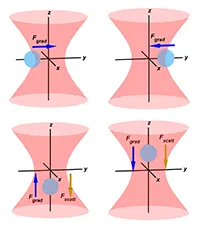Another Wavelength: Jeffrey Melzer

This month in Another Wavelength, we chat with 4th year Ph.D. Student Jeffrey Melzer, currently mentored by Euan McLeod.
Where are you from?
I was born and raised in West Windsor, New Jersey. Until I moved to Tucson for graduate school, I had never lived anywhere outside of Jersey.
What brought you to study optics?
My interest in optics stems from my undergraduate research experience. Although I studied materials science for my undergraduate degree, I worked in a lab that fabricated optical fibers. I quickly found myself more interested in my research than the degree that I was pursuing. After earning my bachelor's degree, I went on to pursue higher education and research opportunities in optics so that I could better understand and appreciate the field I had enjoyed so much as an undergraduate.
Who is your hero in science?
I have two heroes in science. One is Arthur Ashkin, who recently received the Nobel Prize in Physics. I think I have read all of his publications on optical tweezers and it's really cool to see the progression of the technology during its early stages, especially the images and video clips from the earliest implementations. Since I work with optical tweezers as well, I have the ultimate respect for what he has accomplished. My other hero in science is my former research advisor, James Harrington. He developed hollow-core optical waveguides which formed the basis of my undergraduate research. He helped me grow as both a scientist and an individual and his passions for science, optics, and mentorship were truly inspiring.
Describe your research in 20 words or fewer.
I use a laser beam to manipulate small objects that I assemble into cool structures.
Describe your research in 200 words or fewer.

My research is centered around optical tweezers. I use this technology to manipulate small objects (typically dielectric or metallic spheres) in 3-dimensional space. The objects are coated with biological linker molecules such that they will bind to each other when they come into contact. If we position these objects in a serial fashion, then we can build up extended structures using individual building blocks - basically, an optical tweezers based bottom-up assembly technique. The main advantages of using optical tweezers to build structures include biocompatibility (we can use live cells as building blocks!), the ability to trap a variety of objects (various shapes, sizes, and materials), and precise 3D positioning capability. Ultimately, we are capable of building complex, multimaterial, 3-dimensional structures with good resolution, which can be challenging or often impossible using existing nanofabrication techniques. This gives rise to the ability to fabricate unique optical structures, such as metamaterials or photonic crystals.

Name three neat facts about you.
- I have a Shih Tzu named Fluffy. He is quite fluffy.
- I used to play trumpet in a ska band.
- I strive to become trilingual (English, Spanish, and Vietnamese).
